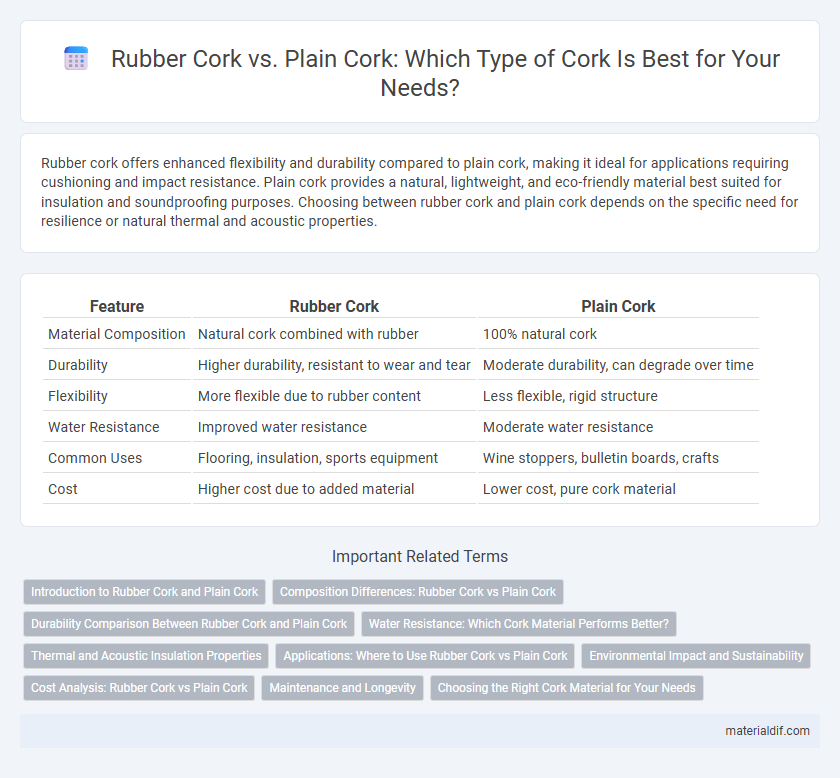Rubber cork offers enhanced flexibility and durability compared to plain cork, making it ideal for applications requiring cushioning and impact resistance. Plain cork provides a natural, lightweight, and eco-friendly material best suited for insulation and soundproofing purposes. Choosing between rubber cork and plain cork depends on the specific need for resilience or natural thermal and acoustic properties.
Table of Comparison
| Feature | Rubber Cork | Plain Cork |
|---|---|---|
| Material Composition | Natural cork combined with rubber | 100% natural cork |
| Durability | Higher durability, resistant to wear and tear | Moderate durability, can degrade over time |
| Flexibility | More flexible due to rubber content | Less flexible, rigid structure |
| Water Resistance | Improved water resistance | Moderate water resistance |
| Common Uses | Flooring, insulation, sports equipment | Wine stoppers, bulletin boards, crafts |
| Cost | Higher cost due to added material | Lower cost, pure cork material |
Introduction to Rubber Cork and Plain Cork
Rubber cork combines natural cork granules with synthetic rubber binders to enhance flexibility and durability, making it ideal for industrial sealing applications. Plain cork consists solely of natural cork material, prized for its lightweight, compressibility, and excellent insulation properties in products like wine stoppers and floor tiles. Both materials derive from the bark of cork oak trees, but rubber cork offers improved resistance to moisture and mechanical wear compared to plain cork.
Composition Differences: Rubber Cork vs Plain Cork
Rubber cork combines natural cork granules with synthetic rubber binders, enhancing flexibility and durability, while plain cork consists solely of natural cork material, offering rigidity and breathability. The inclusion of rubber in rubber cork improves resistance to moisture, making it ideal for applications requiring water repellency. Plain cork's composition ensures lightweight properties and excellent insulation, commonly used in traditional cork stoppers and insulation products.
Durability Comparison Between Rubber Cork and Plain Cork
Rubber cork exhibits superior durability compared to plain cork due to its enhanced elasticity and resistance to wear, making it ideal for high-traffic flooring and industrial applications. Plain cork, while natural and eco-friendly, tends to degrade faster under heavy stress and moisture exposure, limiting its longevity in demanding environments. Selecting rubber cork ensures prolonged lifespan and maintains structural integrity better than plain cork over time.
Water Resistance: Which Cork Material Performs Better?
Rubber cork offers superior water resistance compared to plain cork due to its enhanced elasticity and density, making it highly effective in preventing moisture penetration. Plain cork, while naturally water-resistant, tends to absorb more moisture over time, leading to potential degradation in humid or wet environments. For applications requiring sustained exposure to water, rubber cork is the preferred choice for durability and long-lasting performance.
Thermal and Acoustic Insulation Properties
Rubber cork outperforms plain cork in thermal insulation due to its denser composition, offering superior heat retention and energy efficiency in building applications. Its elasticity also enhances acoustic insulation by absorbing sound vibrations more effectively, reducing noise transmission compared to the more rigid plain cork. These properties make rubber cork a preferred choice for environments demanding enhanced thermal and acoustic performance.
Applications: Where to Use Rubber Cork vs Plain Cork
Rubber cork is ideal for applications requiring enhanced flexibility, durability, and resistance to moisture, such as gaskets, flooring underlays, and vibration dampening pads. Plain cork excels in insulation, packaging, and decorative uses where natural texture, lightweight properties, and environmental sustainability are prioritized. Choosing between rubber cork and plain cork depends on the specific requirements of durability, elasticity, and functional performance in industrial, architectural, or consumer products.
Environmental Impact and Sustainability
Rubber cork, derived from the bark of the cork oak tree, offers superior environmental benefits compared to plain cork due to its renewable harvesting process that does not harm the tree, promoting biodiversity and carbon sequestration. Plain cork, while naturally biodegradable, often involves more energy-intensive manufacturing and less efficient resource use, leading to a higher carbon footprint. Sustainable cork production emphasizes the preservation of cork oak forests, which play a crucial role in combating climate change and supporting local ecosystems.
Cost Analysis: Rubber Cork vs Plain Cork
Rubber cork typically costs more upfront than plain cork due to the added rubber material and enhanced durability, making it a preferred choice for applications requiring higher resistance to impact and wear. Plain cork, being a natural and less processed product, offers a cost-effective solution with lower initial investment but may incur higher replacement expenses over time due to its susceptibility to damage. Evaluating the total cost of ownership, including maintenance and lifespan, positions rubber cork as a better long-term economic option despite its higher initial price.
Maintenance and Longevity
Rubber cork offers superior durability and resistance to wear compared to plain cork, making it easier to maintain over time. Its elasticity allows it to withstand repeated compression without crumbling, extending the lifespan of cork products by several years. Plain cork, while natural and breathable, tends to degrade faster when exposed to moisture and heavy use, requiring more frequent replacement and maintenance.
Choosing the Right Cork Material for Your Needs
Rubber cork offers enhanced flexibility and water resistance, making it ideal for applications requiring cushioning and durability, such as gaskets and flooring. Plain cork, derived from the cork oak tree, provides natural insulation, lightness, and eco-friendly properties suited for bulletin boards and wine stoppers. Selecting the right cork material depends on balancing physical performance with environmental impact and specific project requirements in Cork industries.
Rubber Cork vs Plain Cork Infographic

 materialdif.com
materialdif.com